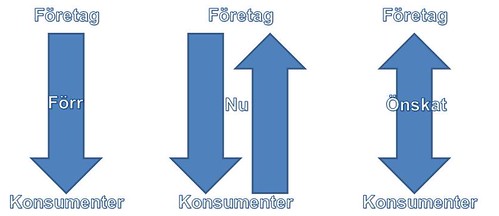Unga kvinnor med intresse för modebloggar och vardagsbetraktelser dominerar fortfarande den svenska bloggosfären. Det indikerar den fjärde årliga undersökningen av svenska bloggare och bloggläsare – BloggSverige 4. Mellan den 8 och 9 februari 2009 svarade totalt 1.500 personer på en online-enkät och av dem hade 1.065 en egen blogg. Här redovisas svaren från dessa drygt tusen svenska bloggare.
Den typiska svenska bloggaren i enkäten är:
– kvinna
– 16-20 år gammal
– läser 6-10 bloggar dagligen
– spenderar 6-10 timma per vecka med att läsa bloggar
– läser oftast bloggar på kvällstid (ca 18-24)
– läser helst bloggar om vardagsbetraktelser
– läser bloggar för att bli underhållen
– har någon gång klickat på en annons på en blogg
– är medlem i ett socialt nätverk för att hålla kontakt med vänner
– har de senaste 12 månaderna delat med sig av både en negativ och en positiv upplevelse av ett företag, produkt eller tjänst
– skriver inte på en mikroblogg
– tror inte att sociala medier som bloggar, mikrobloggar och sociala nätverk kommer att ha betydelse för vilket parti hon röstar på i nästa val
– bloggar för att hon gillar att skriva
– uppdaterar sin blogg varje dag
– har inget emot att bli kontaktad av företag i sin egenskap av bloggare
– är inte anonym
– har inte egna annonser på sin blogg
Några skillnader mot enkäten 2008 när det gäller den typiska bloggaren:
– läser fler bloggar
– spenderar mer tid med att läsa bloggar
– fler har någon gång klickat på en annons på en blogg
– har blivit än mer positivt inställd till att bli kontaktad av företag
Klicka nedan för att se svaren från enkäten.
http://www.flickr.com/apps/slideshow/show.swf?v=69832
När det gäller företag och sociala medier så kan man något förenklat säga att fram till för några år sedan var medielandskapet fortfarande format så att kommunikation oftast gick från företag eller organisationer till mottagarna, dvs konsumenter. Återkoppling från mottagaren var begränsad. Med framväxten av sociala medier har konsumenter fått en egen publiceringsplattform där de kan uttrycka åsikter om varumärken och dela information om produkter med andra. Men svaren i denna enkät speglar inte en dialog mellan företag och konsumenter, snarare en situation där två sändare pratar förbi varandra. När bloggare publicerar negativa åsikter om produkter eller tjänster får de sällan något svar från företagen. Den konkreta dialogen sker istället mellan konsumenter. Vad företag bör göra är att i högre grad skaffa sig en policy för när och hur de ska etablera direkt kontakt med konsumenter.

Även fortsättningsvis är det stor skillnad på vad kvinnor och män helst läser för typ av bloggar.
Kvinnliga bloggare läser helst om:
– Mode och design 60,0%
– Vardagsbetraktelser 58,2%
– Foto och konst 48,6%
Manliga bloggare läser helst om:
– IT och bloggande 63,7%
– Journalistik och media 56,8%
– Politik och samhälle 50,0%
Hela undersökningen finns nedan. Presentationen läses med fördel i fullskärmsläge.
BloggSverige 4http://static.slidesharecdn.com/swf/ssplayer2.swf?doc=cdocumentsandsettingskullinhminadokumentprivatbloggsverige4bloggsverige4-090407121347-phpapp02&stripped_title=bloggsverige-4-1259931
Om undersökningen
Urvalet av respondenter har skett via så kallat bekvämlighetsurval genom word-of-mouth bland bloggar. Det innebär att resultaten i enkäten endast med säkerhet är representativt för respondenterna och inte med nödvändighet för alla svenska bloggare och bloggläsare. Därav följer också att jämförelser med BloggSverige 1, 2 och 3 inte går att göra med statistisk säkerhet. BloggSverige 1 genomfördes i maj 2005, BloggSverige 2 i juli 2006 och BloggSverige 3 i januari 2008.
Om mig
Arbetar som PR-konsult och nordiskt ansvarig för digital PR på Burson-Marsteller. Har bloggat på Media Culpa sedan februari 2004 och bloggen rankas av den amerikanska tidningen Advertising Age som en av världens 150 mest inflytelserika bloggar inom media och marknadsföring.
Mobil: 070-291 78 22, E-post: hans.kullin@bm.com.
Twitter: http://www.twitter.com/kullin , Jaiku: http://kullin.jaiku.com
Bloggy: http://kullin.bloggy.se , SlideShare: http://www.slideshare.net/kullin
BloggSverige 3 kan läsas här.
PS. Om ni bloggar om enkäten, tagga gärna inläggen med bloggsverige4 eller #bs4 på Twitter.
Tags: social media, blogsweden4, surveys, enkät, sociala medier, bloggsverige4, digital pr. Ping.

